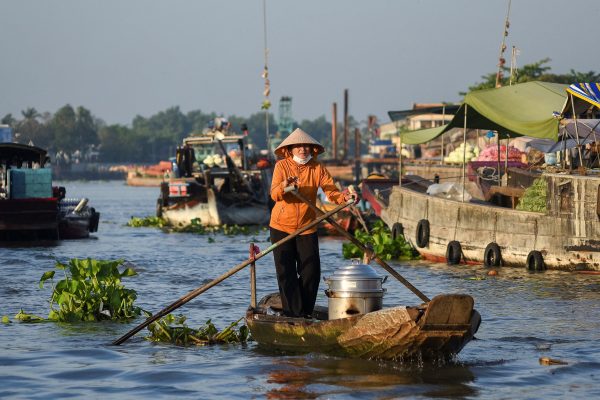Climate change has played a role through the effects of reduced rainfall, rising temperatures, and extreme weather events. But many scholars argue that these transformations cannot solely be attributed to climate change — and that an important part of the explanation lies in the operation of large-scale hydropower dams in the upper stretches of the river.
With a controlling role in the delta, some argue that China holds back a significant amount of water for the sake of its own development, with knock-on implications and costs for downstream users. The Mekong Agreement of 1995 provides China with the statutory authority and mechanisms to retain water for its own ‘reasonable and equitable use’, though this definition is nuanced and complicated, as noted by the Mekong River Commission. Downstream countries, notably Laos, also contribute to the problem by pursuing the construction of a wide array of dams, both in tributaries and the mainstream.
Ongoing debate about the mediating role of Chinese dams in regulating downstream water flows continues. Many express their doubts about the role that the Mekong River Commission plays in monitoring the hydrological regimes across the geographical span of the Mekong River, aside from the well-functioning knowledge hub it provides for the Mekong countries.
The fragmentation of the Mekong due to the construction of large-scale hydropower dams illustrates the inability of downstream states to shape the definition of ‘reasonable and equitable’ use into one focussed on regional aims, rather than centred around national interests.
But there have been some successes. Most notably, the moratorium on the building of two mainstream hydropower projects — Sambor and Stung Treng — by the Cambodian government is a positive sign that downstream countries are recognising and responding to negative transboundary implications. That said, the decision may only be short-term, as it is a national commitment with narrow jurisdictional limits. The complexity of the transboundary water implications cannot be meaningfully tackled through fragmented national actions.
There are concerns as to whether Vietnam is able to address the complexity of the transboundary water challenges faced by agrarian communities in the delta. Hydropower dams in the Central Highlands of Vietnam devastatingly impact downstream areas. This puts Vietnam in an awkward position considering the engagement of Vietnamese companies in the construction of the mainstream hydropower Luang Prabang dam, and other dams in Laos. Whatever the rationale behind this investment in the Luang Prabang project, benefitting from upstream developments in this way undermines any arguments that Vietnam might make about the negative downstream consequences in the delta.
There is much uncertainty about the longer-term changes to the Mekong’s hydrological regime. But a significant out-migration from the delta is already occurring, with the rural poor abandoning the delta in search of employment in urban areas. How national governments will respond to the effects of climate change, however, is unclear. Will Cambodia, for example, decide to reactivate its dam-building plans? If so, processes that are already underway in the delta would accelerate, with significant implications for the delta’s population.
Transboundary hydrological transformations present unprecedented risks to the delta. At the local scale, a mix of control and adaptive measures have been undertaken to deal with externalities. But these local efforts are insufficient as a long-term solution to the emerging challenges. Rather, it demands the strong determination of Vietnam’s government to push forward an agenda that will establish a Mekong-wide dialogue platform to diagnose and resolve the challenges of transboundary water management. Meaningful cooperation towards improving Mekong hydrological conditions must also be facilitated, and benefits shared between upstream and downstream countries.
At the regional scale, it is time for Mekong riparian countries and the Mekong River Commission to look beyond their business-as-usual practices. Instead of solely relying on hydropower projects that have caused detrimental transboundary consequences, alternative energy solutions must be ramped up. There is great potential to invest in solar and wind projects, especially on the coast of Vietnam. But while these energy development pathways are progressing, the lives of millions of Mekong residents still hang on the uncertainty characterised by the sporadic benevolence of upstream countries as well as their strong political will to increasingly squeeze the Mekong flows.
Thong Anh Tran is an Honorary Lecturer at the Fenner School of Environment and Society, College of Science, The Australian National University, and a Research Fellow at Fulbright University Vietnam.
This work comes under the project ‘Sustainable Governance of Transboundary Environmental Commons in Southeast Asia’, funded by the Social Science Research Council of the Singapore Ministry of Education.


Apropos the Mekong delta’s transboundary water problems, I wish to supplement the the topic. Mekong River, which was once (1950s) considered as a challenge to the cooperation among the countries of Mainland Southeast Asia, is still a lifeline inasmuch as it is a perennial river entailing a multitude of benefits to the riparian states. Mekong River Commission of 1995, like UNO, is an animal with no teeth. As a consequence, China has a cascade of dams constructed across the upper Mekong in its territory with no concern for the legitimate share of the lower riparian states. Yes, the suggestion for harnessing the alternative sources of energy does hold good. Does it mean that China is entitled for lion’s share in the Mekong waters. The declined flows in the Mekong, as rightly pointed out by Thong Anh Tran, accelerates the salt water intrusion in the delta region; and no need to underscore the facts the declined flow would deprideprive the people of their livelihood.
The Mekong Delta is impacted by both freshwater scarcity upstream and saltwater intrusion, posing a threat to the region’s sustainable lifestyles. The Mekong Delta’s tale does not end with natural catastrophes or human influences on a macro level; at the local level, the issue of “far away from home” and the quality of human resources via education and training are still very much alive.